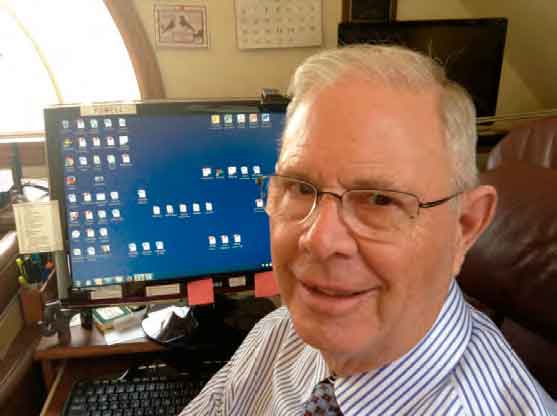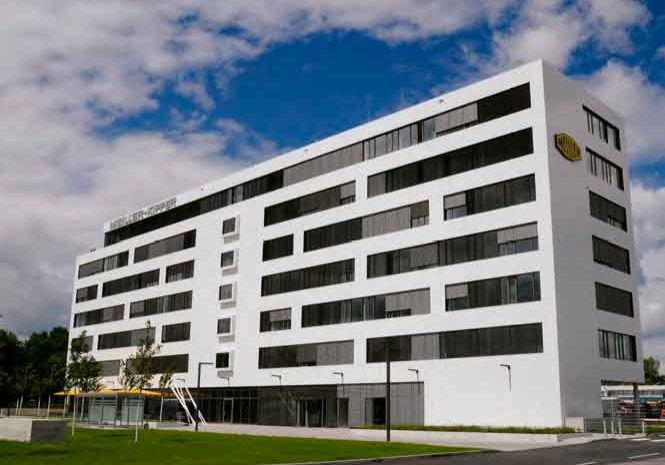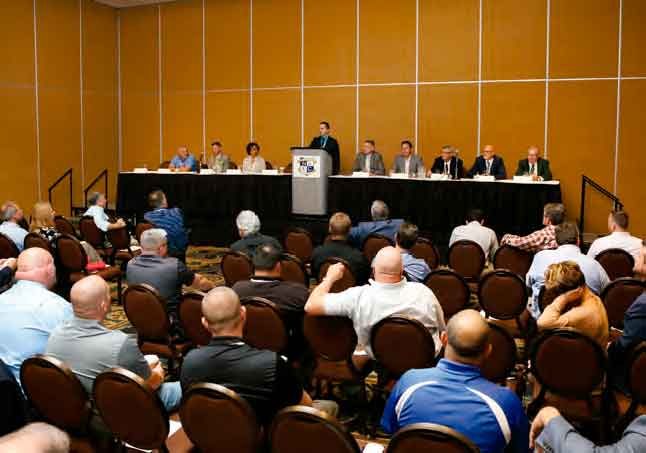More Than Math
Dec 1, 2018

In this Industry Dialogue, Dr. Bruce Powell provides insight about himself, his illustrious career and the state of the VT industry today.
Dr. Bruce Powell is a math nerd, sure, but with the clever, subtle-yet-blunt sense of humor of a right- brained comedian. He began his distinguished career at Westinghouse’s R&D center in the 1960s, when computers were at least the size of refrigerators, New York City’s (NYC) Twin Towers had not yet been built, and print newspapers were read daily in homes and offices. These days, Powell is “boss of himself ” as principal of The Bruce Powell Co., Inc., a consultancy based in Canton, Connecticut. For the past 16 years, he has primarily served as principal traffic analysis consultant for thyssenkrupp on projects including One World Trade Center in NYC, the 80-story Federation Tower in Moscow served by a TWIN elevator system and major modernizations incorporating destination dispatch (DD), such as at One Wells Fargo Center in Charlotte.
Powell is well known throughout the “elevator world” as he continues to tackle each new project as if it is the most interesting and challenging of his career. He took the time to speak with ELEVATOR WORLD about his path to the industry, his personal life, how he used algorithms to help develop 37 patents, multiple publications and the people who have inspired and mentored him along the way. The former Otis Fellow shared fascinating insight about the future of new technology, the state of the consultancy industry today and the challenges that come with traffic analysis.
EW: Where were you born, where did you grow up, and at what point in your life did you decide on a career in the vertical-transportation (VT) industry?
BP: I was born and raised in Waterbury, Connecticut, but I am not sure that I ever fully grew up. I seriously doubt that anyone decides early in life to make a career in the VT industry. Like many college kids, I wrestled with the issue of what to do for a career. I thought about dentistry but lacked the prerequisite biology courses. Then, because church had been a big part of my youth, I considered the ministry but was discouraged by my Harvard MBA accountant father. That left pursuing further education in mathematics and computers. At that time (early 1960s), serious computers filled two conference rooms, and apples were for making pies and for winning favor from the teacher.
I went to graduate school in Cleveland at Case Institute of Technology (now Case Western Reserve University). Through a combination of good decisions and a lot of luck, I went down a path that led to a PhD in Operations Research and a position as a research mathematician at Westinghouse Electric Research Laboratories in Pittsburgh. It was there that my skills in mathematical modeling and technical communication met with Westinghouse Elevator Co.’s need to develop a more solid technical approach to elevator design and more clever dispatching algorithms. After 21 years at Westinghouse, I joined Otis in their Advanced Research department, spending 13 years in Farmington, Connecticut.
Finally, leaving corporate America behind, I became “president of myself,” working full time as an elevator consultant, mostly working with thyssenkrupp Elevator. It has been an interesting journey!
EW: You have been named an Otis Fellow and hold many patents. Of what professional accomplishment are you proudest?
BP: I have my name on 37 patents, and the rights of nearly all are owned by Otis. Of these patents, most are shared with other team members. I was fortunate enough to come along when the patent office expanded its scope from “how to build a better mousetrap” to allowing novel mathematical algorithms that could be used to control things such as elevators. Also noteworthy in my career are a number of citations of my work in public literature, namely, The New York Times, the Wall Street Journal, CNN and, of course, EW.
EW: To which professional organizations do you belong?
BP: Over the years, I have belonged to the Operations Research Society of America, The Institute of Management Sciences and the Society for Computer Simulation. I have also been active in presenting papers to the International Association of Elevator Engineers.
EW: If you could change one thing about our industry, what would it be?
BP: I would like to convince the segment of the industry that advises building owners, developers and architects that there is a world beyond the calculation of up-peak interval and handling capacity. This new world that I jumped into at Westinghouse in 1967 consists of dispatch algorithms with a solid mathematical foundation and a focus on estimating passenger waiting time (WT) and average time to destination (ATD). We don’t have to bore our customers with mathematical details, but we must base our recommendations about good elevator configurations on computer-simulation models and input data gathered during traffic surveys at fully occupied buildings.
EW: Which colleagues in the industry inspire you and why? Did you have any mentors during your career you would like to mention?
BP: My career began at Westinghouse under Dr. Robert Hooke and Dr. Douglas Shaffer. These men were truly gentlemen and scholars. Bob Hooke fine-tuned my technical writing skills, and Doug Shaffer taught me the fundamentals of presenting technical information to non-technical people. Colleagues who have been quiet mentors, some without their knowledge, include John Kendall and Joe Walker, Otis; Rory Smith and Mark Schroeder, thyssenkrupp; Dr. Richard Peters, Peters Research Ltd.; consultant Rick Barker, Barker Mohandas LLC; and the Rev. William Paul.
EW: Which of your consultancy projects did you find most challenging/rewarding?
BP: The most challenging and rewarding consultancy project is the last one and the next one. Each job has little wrinkles that make it unique and challenging. Since I specialize in traffic analysis, which most often happens at the front end of the development of a building, my time spent on a particular project is short compared to that of design and construction engineers who might spend years with one major job. Over the years, I have worked on several hundred elevator projects, both small and large.
Another challenge involves convincing customers that the latest technological buzz (“fuzzy logic,” “artificial intelligence,” etc.) does not necessarily result in improved performance. You know what? The old timers really did know what they were doing.
EW: Was there any particular project or projects you worked on that really influenced you or changed your perception of this industry and its impact on society?
BP: I have been particularly interested in how slow the industry has been to embrace the control system we now call destination dispatch (DD). The fundamental concept of DD was invented nearly 60 years ago in Australia, several years before microprocessors were used to control elevators. Either for reasons of technical skepticism or product-strategy issues, the adoption of DD had been slow. Only in this century has DD gained momentum to the present, where it is often now the default specification for high-end office buildings.
EW: On a related note, how do you feel about the future of new technologies such as TWIN and, more recently, MULTI? Are they really game changers? Why or why not?
BP: Like DD, the concept of two elevators running independently in a single shaft is not new. Patents related to this technology were issued as far back as 1907. A working system as documented in Scientific American was installed by Westinghouse in its East Pittsburgh manufacturing plant in 1931. So, it has taken more than 100 years to get to the place where elevators with two cars in hoistways are carrying passengers in office buildings in several European cities and will be doing the same very soon in major cities in the U.S. Are these technologies game changers? We will see.
EW: What is the biggest professional challenge you face currently, and how are you addressing it?
BP: Above, I referenced convincing recipients of my work that there is more to good traffic analysis than Round Trip Time and Interval calculations. A customer might come to me determined to use DD in, say, his five-story hotel. I struggle to convince him that DD may not be a good fit. I use publicly available simulation software, as well as a clear and concise presentation, to argue the pros and cons.
EW: What does your professional future hold? Do you have plans to retire anytime soon?
BP: I am well past the age when I am eligible to receive full Social Security benefits. Nearly all my contemporaries have retired, so I suppose that I should follow them soon.
EW: You have worked all over North America and the world. Which cities do you feel are most advanced and receptive to new VT technology?
BP: Europe has a substantial number of TWIN elevator systems operating today. The West Coast of the U.S. seems to have adopted DD more readily than other parts of the U.S., although that is changing. The Japanese elevator companies seem to have adopted advanced control algorithms more readily, although this is difficult to verify. After all, “It’s only software!”
EW: Describe the state of the consulting industry today. Are there plenty of qualified, motivated candidates? Why or why not?
BP: Back in the “good old days,” the fact that elevator suppliers were very reluctant to release technical information led to the growth of the elevator consulting industry. Looking for a change of scenery, many salespeople, as well as engineers, became consultants.
There is no uniform set of qualifications or certification, so anyone who so chooses can hang a shingle. This leads to nonuniformity in qualifications, but I suppose that this is just like almost every other profession. In the last couple of years, lift consultants have been extremely busy. There seems to be more work than people available to provide technically solid consulting.
EW: What advice would you give to someone considering getting into the elevator industry today?
BP: Think about being a dentist or a minister first. If that doesn’t work, then try what I did. But, seriously, as silly as it sounds, a person cannot be an effective consultant without knowing the key aspects of the product. This can most practically be obtained by working for an elevator supplier.
The two attributes that I would look for in a person who wishes to be a consultant are, first, a keen interest in technical mathematical details and, second, a passion for clear and concise written and oral communication (not necessarily in that order).
EW: Is there a particular project you admire that you’d like to tour or pick the brains of those responsible for it?
BP: I admire the Eiffel Tower in Paris for its technical achievements and staggering beauty. Considering that it was completed in 1889, the elevators that travel diagonally up the legs and the duo-lift passenger cars that travel to the upper platform some 906 ft. from the ground are impressive. The copies of communications I have seen between Gustav Eiffel and Otis are fascinating.
EW: Tell me about your family.
BP: Marlene and I have been married for 54 years. We raised three daughters to be fans of Pittsburgh Steelers football and Pirates baseball. We encouraged them to cultivate solid values, which included a high regard for technical education, as well as the importance of placing the needs of others first. Over the years, 11 grandchildren filled our home at Christmas and our hearts with joy, as well as trepidation. Now, we spend almost every summer at our camp in the lower Adirondacks in New York and the rest of the year in our home in the northwest hills of Connecticut.
EW: What do you like to do in your free time?
BP: My wife and I have found a great deal of enjoyment and satisfaction singing sacred classical music, as well as contemporary Christian music, in our local Congregational church.
I operate a small powerboat on fresh water, dragging grandchildren around on water skis and tubes. I fancy myself a once-reasonable golfer. My wife and I snow ski, mostly in the western U.S. Finally, in spite of my wife’s overabundance of caution, I often use my chainsaw in the woods.
EW: What’s the last book you read that was not elevator related?
BP: Spending a career with my nose in technical literature, I am not a fast reader. That said, I have enjoyed the work of Mitch Albom, specifically, Tuesdays with Morrie and The First Phone Call from Heaven.
EW: Where did you go on your last vacation, and what is your favorite vacation spot?
BP: Since 2002, my wife and I have taken at least one international trip per year. We have been to countless places, favorites among these being Paris, London, Ireland, Machu Picchu, and the Galapagos Islands. Our most recent trip was to Iceland. Some people call this “spending our kids’ inheritance.”
EW: Looking back now, is there anything you would have done differently, professionally speaking?
BP: I would like to have had more time allocated to going back into a newly constructed and fully occupied building for which I recommended the elevator configuration to see how things worked out. Also, I would like to learn how things would have worked out for Dr. Bruce Powell the dentist or the Rev. Bruce Powell the minister.
Get more of Elevator World. Sign up for our free e-newsletter.









